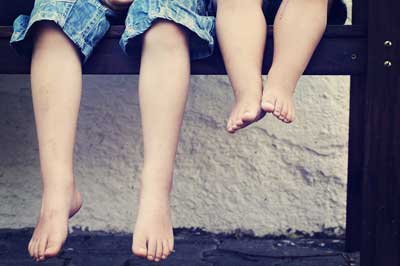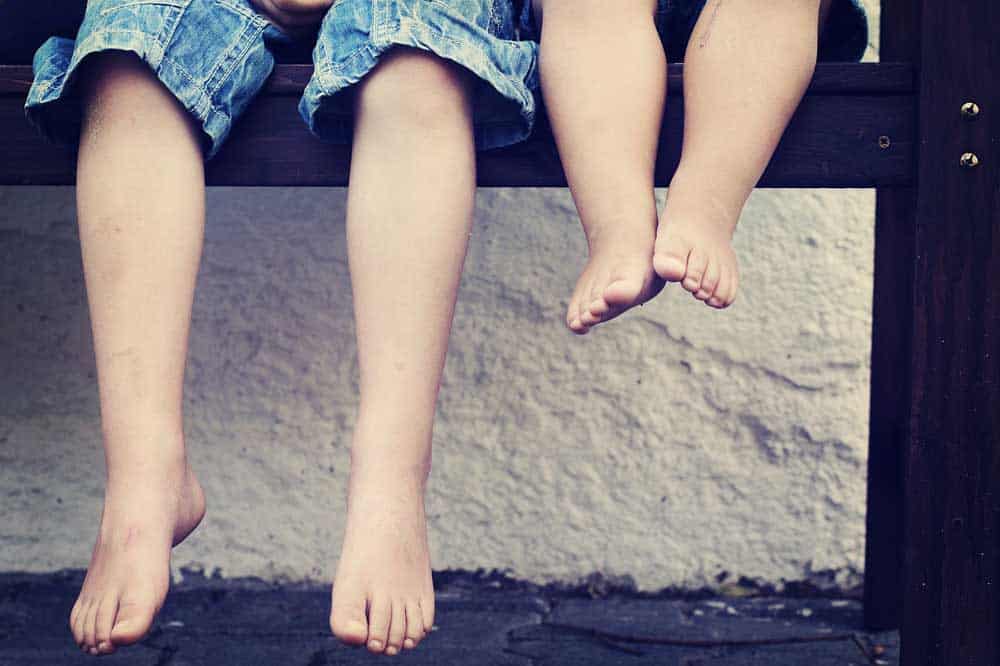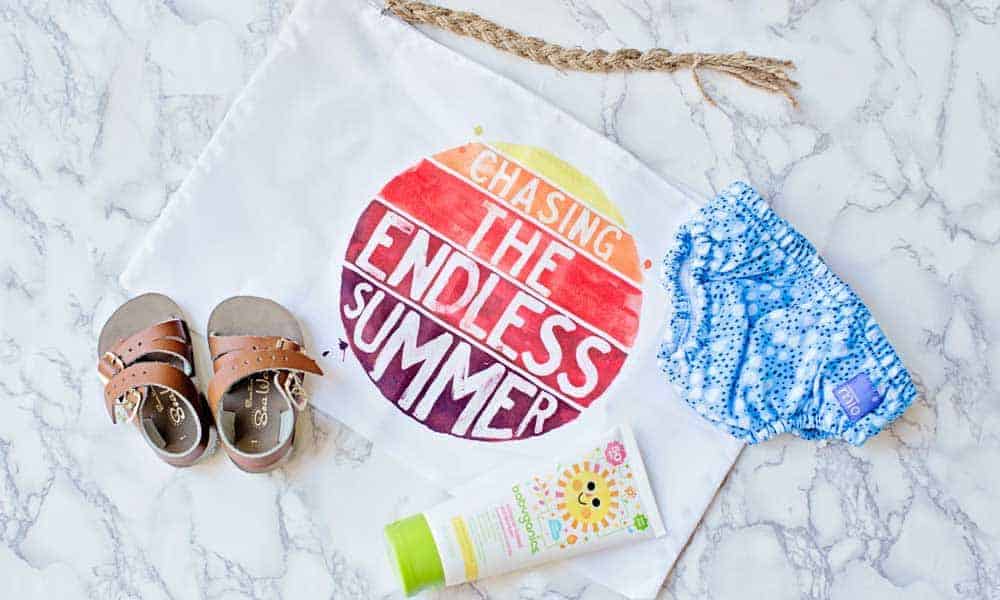
Blog, Kids Feet

Knee pain in kids
“Knee pain almost exclusively only affects active kids,” says sports podiatrist and founder of A Step Ahead Foot + Ankle Care Dr Brenden Brown.
“In the majority of cases the knee pain will be related to a specific period of activity.
“Sometimes you have to look back 12 hours before the pain starts to pinpoint the activity that caused it. For example, a child might be sore and suffering from a really painful knee on Sunday yet because they didn’t hobble off the footy field after their game on Saturday the parents don’t relate the pain to playing football.”
Causes of kids’ knee pain
Dr Brenden says knee pain in children is predominantly caused by Osgood-Schlatter disease.

What is Osgood-Schlatter disease?
Osgood-Schlatter disease is characterised by a painful lump just below the kneecap.
According to the American Academy of Orthopaedic Surgeons, ‘Osgood-Schlatter disease most often occurs during growth spurts, when bones, muscles, tendons, and other structures are changing rapidly. Because physical activity puts additional stress on bones and muscles, children who participate in athletics—especially running and jumping sports—are at an increased risk for this condition. However, less active adolescents may also experience this problem.’
Treating knee pain in kids
“The most common treatment approach by practitioners is stretching or advising the child to stop playing sport.
“I disagree,” says Dr Brenden.
“Telling kids to stop playing sport is not a treatment modality. It’s simply avoiding the cause of the pain. Once they start activity again, BOOM the pain re-appears!
“Similarly, stretching alone will not, in most cases, cure the underlying problem. I see children who are given stretching routines by their healthcare professionals time and time again, season after season. If knee pain is an ongoing problem for the child, we should be evaluating their foot posture in order to find the core problem and a positive long-term solution.”
Dr Brenden adds, “There are far too many viable treatment options available which can address the underlying issue of knee pain and keep children active.
“Advising a child to stop playing sport is no longer necessary and is in fact detrimental to child’s long-term health”

Tips to prevent knee pain in kids
—Warm up properly. Before you “warm up” with a jog, try walking at a moderate to brisk pace 4 times around the football field (8 times around a netball court). Start slow, increase as you progress—NEVER run!
—Ensuring you’re wearing the right footwear can help protect the knees. Wear good, supportive, sports-specific shoes (not the trendiest runners you can find!).
“Choosing appropriate footwear that’s specific to the sport being played would likely reduce the amount of foot-related injuries we see by at least 25%,” says Dr Brenden.
—Work on improving the leg muscle strength and flexibility. Isometric strength exercises are readily accessible and can be performed anywhere—even when in pain!
Related articles:
Warming up for sports…why bother?
What’s causing your child’s heel pain?
Common kids’ foot complaints
ABOUT US
A Step Ahead Foot + Ankle Care is one of Sydney’s leading foot and ankle clinics. Principal podiatrist and founder of A Step Ahead Dr Brenden Brown (AKA Dr Foot) has been taking care of people’s feet for more than 20 years.
With a background in sports medicine and having served as a former president of the Australasian Podiatry Council, Brenden is a wealth of information when it comes to foot and ankle care.

Blog, Kids Feet, Uncategorized

Taking care of common kids’ foot complaints
While most parents worry about the health of their child’s eyes and teeth, many overlook the state of their kids’ feet. Feet are amazing; not only do they enable us to stand tall and move, they support our body weight and act as shock absorbers, in turn protecting our ankles, knees, hips and spine.
In young children the foot is pliable to allow it to develop, which means taking care of feet during the first few years of a child’s life is vital.
Recognising common foot complaints can help ensure that action is taken to address the problem and ensure your child’s feet continue to develop in a healthy way.

Ingrown toenails
Ingrown toenails are common with multiple causes. Widespread causes can include clipping the nails too short, cutting or picking at the edges of the nail, trauma to the nail due to kicking sports, excessively sweaty feet and pressure from footwear. All of these events can create a sharp edge on the nail, which can pierce the skin and lead to an ingrown toenail.
The symptoms of an ingrown toenail (onychocrytosis) can include a sore toe, pain at one side of the toenail and, in severe cases, a pus-filled discharge. In most cases it’s usually the big toe that’s affected.
Closed-toe shoes are likely to increase the intensity of the pain and, if left untreated, it’s common for the toenail to become infected making it difficult to walk and particularly painful to play sport.
To treat an ingrown toenail start by soaking the foot daily in warm, salty water, gently patting dry and applying a topical antiseptic. If possible, refrain from wearing enclosed shoes.
If the issue does not resolve within a couple of days it may require treatment by a podiatrist. This is a simple procedure that involves removing the small, sharp portion of nail causing the grief and dressing the nail to protect against infection. It usually takes minutes.
In acute cases nail surgery may be required.

Flat feet
In infants flat feet is common because they have a fat pad under the foot that hides the developing arch. By about the age of eight, the foot arch becomes apparent. Yet some children never develop an arch and this is called ‘flat feet’.
Flat feet or pronated feet (foot and ankle roll inwards) can be hereditary or due to muscle length and tone. In some instances the condition causes no pain or discomfort but in other cases flat feet or over pronated feet can cause pain in multiple areas of the body including the foot itself, shins, knees, lower back and Achilles tendons.
A podiatrist can help treat flat feet using orthotics, which hold the feet in their correct position and help relieve the associated pain. A detailed biomechanical analysis is conducted to diagnose which type of orthotics is best (there are many!).
In addition to orthotics, a podiatrist can advise on other measures that can be taken as part of a multi-pronged treatment plan. This may include stretching, strengthening exercises or deep connective tissue massage. Bare in mind that being overweight or wearing poor footwear can contribute to the symptoms of flat feet.
Plantar warts
Warts can be the bane of a parent’s life because they are so easy to contract, yet notoriously difficult to get rid of.
Often mistaken for corns, plantar warts appear as small (less than 5mm) rough, flat bumps on the bottom of the foot—usually on the underside of the toes, heel or forefoot. Some plantar warts have little black dots in the centre. This is caused by small blood vessels.
Warts are the result of a virus, so they are easily transferred to other children and adults and are particularly common in swimming pools, gyms, communal showers and other places that involve water, warmth and bare feet.
There’s a plethora of treatments for plantar warts but many are lengthy and not always successful. If over-the-counter non-prescription medicines don’t work, you can try a prescription medication such as salicylic acid or cryotherapy, which involves freezing the wart with liquid nitrogen.
Alternatively, your local podiatrist can use laser treatment or a small instrument to remove the wart. To prevent future plantar warts, avoid letting your child go barefoot in high-risk places such as public showers and outdoor swimming pools.
Want to know more about taking care of kids’ feet? Visit: mykidsfootdoctor.com.au.
Got a question? Ask Dr Foot
A Step Ahead Foot + Ankle Care is one of Sydney’s leading foot and ankle clinics. Principal podiatrist and founder of A Step Ahead Dr Brenden Brown (AKA Dr Foot) has been taking care of people’s feet for more than 20 years. With a background in sports medicine and having served as a former president of the Australasian Podiatry Council, Brenden is a wealth of information when it comes to foot and ankle care.
Related blogs:
Does your child need to see a podiatrist?
Are growing pains causing your child discomfort?

Blog

Summer footcare for kids
Beach season often means bare feet for littlies, but without the protection of sandals or trainers the result can be splinters, sunburned feet, blisters and grazed toes—not to mention a fungal infection. So before your kids rush out to play with nothing on their precious feet, make sure they know the potential dangers that could cause them some serious foot pain.
No shoes, no play
“Going bare foot means kids need to navigate their way across griddle-hot pavements, avoid sharp stones, stray glass and objects they could stub their toes on,” says Dr Brenden.
Yet the reality is most kids aren’t great at avoiding foot hazards—so caring for kids’ feet starts with enforcing the rule ‘no shoes, no play!’
Forget thongs
Thongs are commonly the go-to shoes for summers down under, but while they have their place (by the poolside, in public showers and at the beach), they’re not ideal for the health of our feet.
Dr Brenden explains, “Constant thong wearing can result in arch and heel strain, blisters and cracked feet. If possible, choose a pair of lightweight runners or sandals that are easy to put on and take off but will also provide your child with the foot support they need for their growing feet.”
Beat blisters
Blisters are commonplace in summer, due to the hot, humid weather. Thongs, in particular, can cause blisters between the toes and across the tops of the feet where the plastic strap rubs the skin. Likewise, trainers can also cause blisters at the back of the heel and between the toes.
To protect your child from blisters, ensure they wear clean socks with their trainers and apply foot balm or Vaseline to culprit areas to help stop the chaffing.
If a blister does develop, don’t pop it. Use a special blister plaster as this protects the blister and helps to remove some of the pressure.
Say no to splinters
Splinters can be really painful and uncomfortable for children, especially if they’re on the soles of the foot. If you’re lucky and the splinter is sticking out far enough you might be able to pull it out wit tweezers. If not, soak the foot in warm water for a few minutes until the skin softens. Use sterilized tweezers to grasp the object at the site where it emerges from the skin and pull it out.
If using tweezers fails, take a sterilized needle and carefully slit the skin above the splinter. Then use the tweezers to remove the object from the foot.
Wash the area with warm, soapy water, dry thoroughly and apply some antiseptic to safeguard against infection.
Stop infection
Protecting against cuts and grazes is one thing, but keeping any existing foot injuries covered to avoid infection is essential too. If you’re sick of Band-Aids falling off, try a silicone gel.
Banish the burn
There are a number of areas of the body that are prone to sunburn—simply because these are the spots we all tend to forget to apply sunscreen to. One such area is the top of the feet. So when applying sunscreen, don’t stop at your kid’s ankles, make sure you spread sunscreen over their feet and toes too.
Teaching kids the importance of optimal foot care will not only help to protect their feet during summer, it will help promote a lifetime of foot health.

Dr Brenden’s top tips for taking care of children’s feet in summer
- Trim toenails and keep them short
- Limit time spent wearing thongs
- Wash feet daily with warm, soapy water and dry thoroughly
- Ensure your kids wear clean socks
- After wearing trainers leave them in the sun to dry
- Don’t forget to apply sunscreen to their feet
- Encourage kids to wear lightweight summer shoes to prevent splinters, grazes and stubbed toes.
Want to know more about taking care of kids’ feet? Visit: mykidsfootdoctor.com.au or check out these related articles:
When should I bring my child to see a podiatrist?
Do you need to get your kids’ feet checked out?
Are your child’s feet healthy?
A Step Ahead Foot + Ankle Care is one of Sydney’s leading foot and ankle clinics. Principal podiatrist and founder of A Step Ahead Dr Brenden Brown (AKA Dr Foot) has been taking care of people’s feet for more than 20 years. With a background in sports medicine and having served as a former president of the Australasian Podiatry Council, Brenden is a wealth of information when it comes to foot and ankle care.















 Dr Brenden’s White paper report on the “6 Reasons You Won’t Beat Heal Pain” outlines what’s stopping you from beating this and tips on how to stop it in its tracks!
Dr Brenden’s White paper report on the “6 Reasons You Won’t Beat Heal Pain” outlines what’s stopping you from beating this and tips on how to stop it in its tracks!